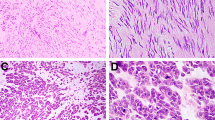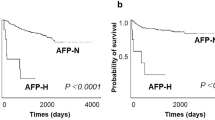Abstract
Immunofluorescence staining for carcinoembryonic antigen (CEA), secretory component (SC), and epithelial IgA was evaluated semiquantitatively in 85 large-bowel carcinomas in relation to degree of tumour differentiation, Dukes' stage, and plasma CEA level. The tumours were divided into a near-diploid (ND, 28) and an aneuploid group (AN, 57) by means of flow-cytometric DNA measurements. Expression of SC and IgA in neoplastic epithelium was positively related to differentiation in both groups. The AN tumours scored significantly higher for CEA than the ND ones, but the staining was apparently unrelated to differentiation or Dukes' stage. CEA expression in the transitional mucosa adjacent to ND tumours was negatively correlated with tumour differentiation, whereas epithelial IgA and SC in this zone showed a substantially higher positive correlation with tumour differentiation, and a somewhat stronger negative correlation with Dukes' stage in the ND than in the AN group. Plasma CEA levels were significantly related to Dukes' stage, only in patients with AN tumours, and only in this group were positively correlated with estimates of total tumour CEA for Dukes' stages A and B. For Dukes' stages C and D (disseminated tumours), moreover, the plasma CEA levels were found to be significantly higher in the AN group. These findings indicate that the DNA profile of large-bowel carcinomas is related both to the way neoplastic cells influence the activity of the transitional mucosa and their capacity for expression and release of epithelial products. AN tumours thus seem to be more active as "secretors" of CEA than ND ones.
This is a preview of subscription content, access via your institution
Access options
Subscribe to this journal
Receive 24 print issues and online access
$259.00 per year
only $10.79 per issue
Buy this article
- Purchase on Springer Link
- Instant access to full article PDF
Prices may be subject to local taxes which are calculated during checkout
Similar content being viewed by others
Rights and permissions
About this article
Cite this article
Rognum, T., Thorud, E., Elgjo, K. et al. Large-bowel carcinomas with different ploidy, related to secretory component, IgA, and CEA in epithelium and plasma. Br J Cancer 45, 921–934 (1982). https://doi.org/10.1038/bjc.1982.145
Issue Date:
DOI: https://doi.org/10.1038/bjc.1982.145
This article is cited by
-
Flow cytometric analysis of DNA content in colorectal carcinoma
Diseases of the Colon & Rectum (1992)
-
The expression of carcinoembryonic antigen and secretory component in adenomas of the human colon and rectum
Diseases of the Colon & Rectum (1989)
-
Multivariate analysis of a tissue CEA, TPA, and CA 19.9 quantitative study in colorectal cancer patients
Diseases of the Colon & Rectum (1989)
-
Comparison of nuclear DNA content and exudative stromal reaction between surgical and autopsy materials from gastric and colorectal carcinomas
The Japanese Journal of Surgery (1988)
-
Cellular DNA content and metastasis pattern in colorectal carcinomas
Virchows Archiv A Pathological Anatomy and Histopathology (1988)



